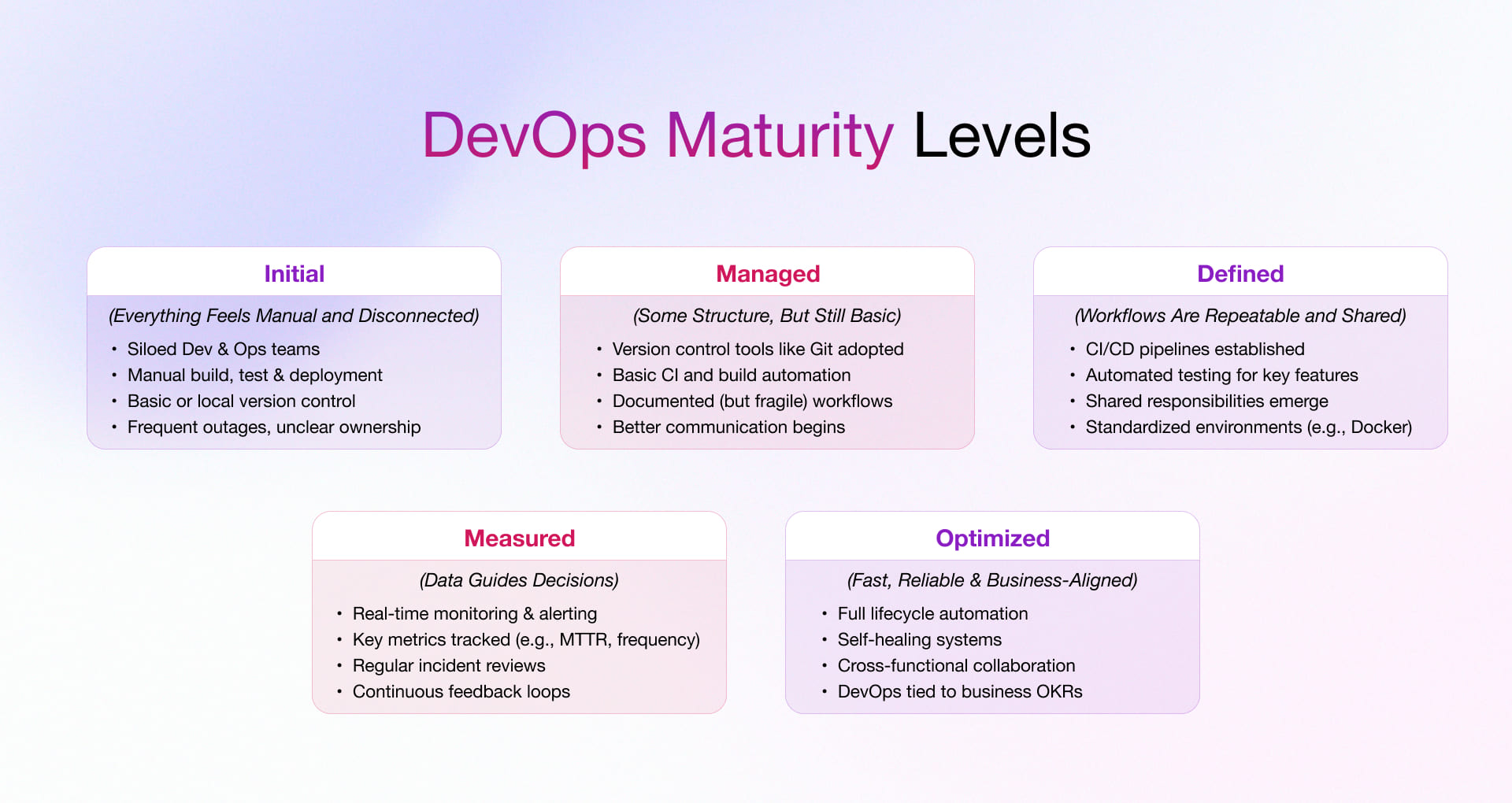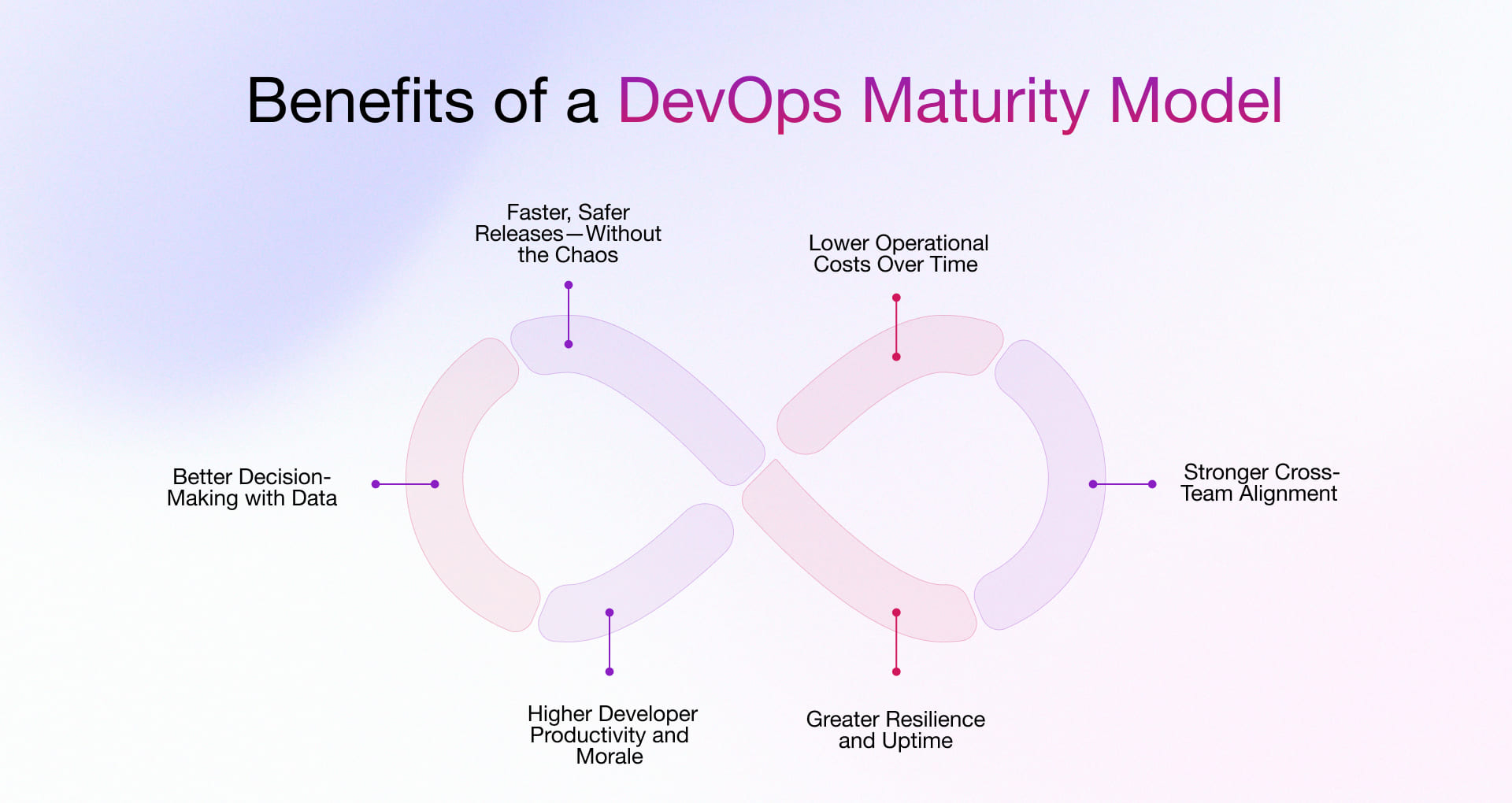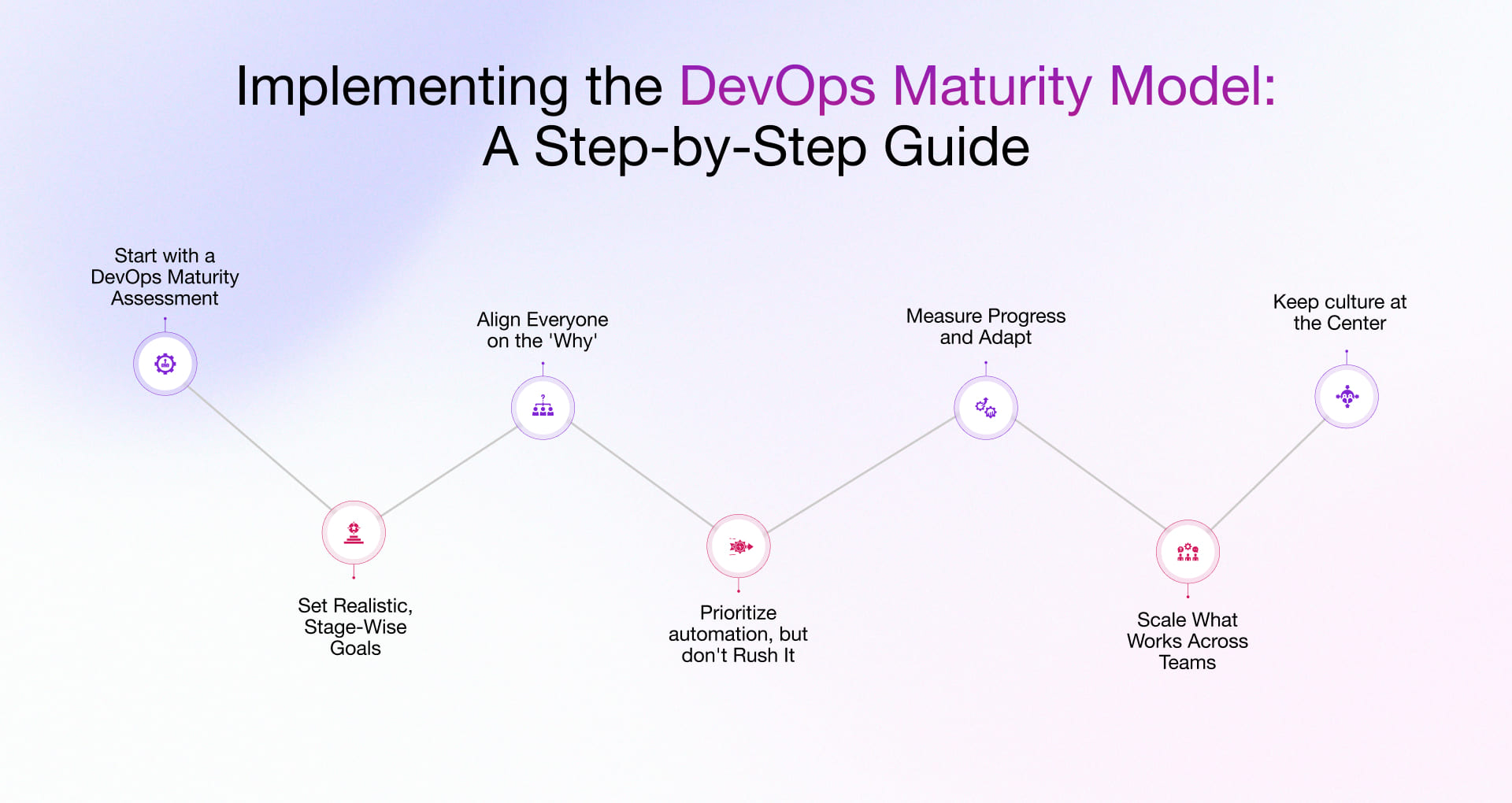You are not alone if your DevOps efforts feel stuck in a loop of isolated wins and repeated issues.
Most enterprises begin their DevOps journey with high hopes—faster releases, fewer failures, and happier teams. However, somewhere along the way, the early momentum fades, and teams find themselves firefighting the same problems again and again. Instead of steady improvement, they rely on quick fixes rather than building a solid, clear strategy.
That’s where the DevOps Maturity Model shifts the conversation.
It’s not just a framework. It’s your reality check.
For CTOs and DevOps leaders, it answers the hard questions:
- Are we moving fast and safe?
- Are our teams equipped to scale delivery without scaling chaos?
- And most importantly—what’s standing between our current state and continuous improvement?
In this blog, we’ll walk you through the DevOps Maturity Model: what it is, how its five levels help you benchmark your current state, and why assessing your maturity can unlock real business value. From understanding the fundamentals to exploring real-world examples and implementation strategies, we’ll also discuss how to move from lagging DevOps practices to confident, scalable delivery.
Understanding the DevOps Maturity Model
DevOps isn’t something you “install” once and forget. It’s a journey that moves from scattered efforts to seamless and scalable delivery. The DevOps Maturity Model helps organizations figure out where they currently stand and what steps they need to take to move forward.
At its core, it’s a DevOps maturity framework designed to measure progress across tools, processes, team culture, and delivery outcomes. Whether your teams are still pushing code manually or managing complex CI/CD pipelines, this model helps you assess maturity with a structured lens.
But more than that, it gives CTOs and DevOps managers a shared language for DevOps maturity assessment. A way to align cross-functional teams, set priorities, and make smarter, data-driven decisions around tools, talent, and timelines.
The DevOps Capability Maturity Model offers a layered view for organizations seeking a more formal structure, breaking down how DevOps capabilities evolve from ad hoc practices to automated, optimized systems. Now, let’s break down the core components of this model.
Core Components of the DevOps Maturity Model
To make maturity measurable, every DevOps maturity framework looks at four foundational areas:
Culture & Collaboration
Are your dev and ops teams working in silos, or do they share ownership and accountability? A mature DevOps culture is built on trust, communication, and a shared sense of purpose.
Processes
From planning to release, how streamlined are your workflows? This includes how you manage code, releases, incidents, and feedback loops. Maturity means less friction, fewer delays, and consistent improvement.
Technology & Automation
Automation is not a bonus; it’s a baseline. The model assesses the extent to which automation is embedded across CI/CD pipelines, infrastructure management, testing, and monitoring.
Measurement & Feedback
Are you tracking what matters? High-maturity teams rely on data, DevOps maturity assessments, DORA metrics, deployment success rates, recovery times, and user feedback to guide decisions and continuously improve.
Each of these components matures over time, from manual, reactive practices to intelligent, proactive operations. And together, they determine how fast (and how safely) you can deliver value at scale.
Five Levels of DevOps Maturity Model
If you’re leading a tech team, one thing is clear: DevOps isn’t a one-time setup. It’s a step-by-step evolution.

The DevOps Maturity Model lays out a structured path. It helps you understand how far your teams have come and what needs to shift, whether it’s tools, workflows, or mindset.
Most teams grow through five stages, moving from reactive to proactive, from patchwork to predictable delivery. Here’s what those five levels typically look like:
Level 1: Initial – Everything Feels Manual and Disconnected
At this stage, DevOps isn’t really in place. Development and operations teams work separately, with no shared tools or practices. Releases are slow and risky. If something breaks in production, it’s all hands on deck, usually without clear ownership.
You’ll often see:
- Code stored locally or in basic version control
- Manual builds, testing, and deployments
- Delays between development and release
- Frequent outages or hotfixes
At this level, there’s more reaction than strategy.
Level 2: Managed – Some Structure, But Still Basic
This is where teams begin to realize the pain of slow delivery and start taking action. You’ll see version control systems in place. A basic CI tool may be introduced. There is an effort to create repeatable processes, even if they are still fragile.
You’ll often see:
- Git or another version control tool in use
- One or two automation tools (usually for builds)
- Some documentation of workflows
- Teams starting to communicate more openly
It’s progress, but it still depends heavily on individuals, not systems.
Level 3: Defined – Workflows Are Repeatable and Shared
DevOps is no longer an experiment. CI/CD pipelines are up and running. Testing is partly automated. Teams begin sharing ownership and responsibilities. There’s a common toolchain and a growing focus on reducing errors before production.
You’ll often see:
- CI/CD pipelines triggering builds and deployments
- Automated tests covering core features
- Environments being standardized (e.g., through containers)
- Fewer last-minute surprises before releases
This is when delivery becomes more stable, and the team begins to trust the process.
Real-World Snapshot: DOOH Company’s DevOps Leap
A global DOOH advertising company partnered with Rishabh Software to streamline its fragmented release process. At this “Defined” stage, the organization sought to standardize its workflows and eliminate bottlenecks. The solution? A full-fledged CI/CD pipeline and centralized DevOps model.
By automating build, test, and deployment cycles using tools like Jenkins, Docker, and Azure DevOps, the company achieved:
- 40% faster release cycles
- 70% fewer post-release bugs
- Seamless collaboration between development, QA, and operations teams
This case illustrates how organizations at Level 3 begin to see tangible outcomes—more predictable deployments, fewer last-minute surprises, and a culture shift toward shared accountability.
This case illustrates how organizations at Level 3 begin to see tangible outcomes such as more predictable deployments, fewer last-minute surprises, and a culture shift toward shared accountability. Read the complete case study to know how we helped a DOOH company streamline DevOps Implementation.
Level 4: Measured – Data Guides Decisions
Here, DevOps maturity takes a serious turn. The team isn’t just delivering code, they’re measuring how well they’re doing it. Feedback loops get shorter. You can see how long releases take, how often issues occur, and how quickly they’re resolved.
You’ll often see:
- Real-time dashboards and alerting
- Metrics like deployment frequency, failure rate, MTTR
- Consistent post-incident reviews and learning
- A culture of continuous improvement
This level is where high-performing teams start to pull ahead.
Level 5: Optimized – Fast, Reliable, and Aligned with the Business
DevOps is fully built into how the organization operates. Teams release confidently and often. Automation covers everything, from builds and tests to deployments and rollbacks. Ops and devs work side-by-side, with business impact at the center of every decision.
You’ll often see:
- Full automation across the lifecycle
- Systems that recover automatically from failures
- Cross-functional teams with shared goals
- DevOps outcomes tied directly to business OKRs
This is the stage where DevOps becomes a competitive advantage, not just an engineering practice.
Why This Model Matters
The DevOps capability maturity model helps you see beyond tools and tickets. It shows you how your culture, processes, and automation stack up and what to improve next. No two teams move through these stages the same way, but having a map makes the journey less overwhelming.
DevOps Maturity Assessment: Where Are You on the Maturity Model?
Before you chase the next big DevOps tool or trend, take a beat. Where are you today?
That’s what a DevOps maturity assessment is all about. It provides a clear picture of your current state, how your teams collaborate, how quickly (and safely) you ship, and how confident you feel with every release.
Because let’s be honest: not every team is in the same place. Some are still juggling manual deployments and last-minute hotfixes. Others are shipping daily with full automation and zero downtime.
But maturity isn’t just about speed. It’s about stability, quality, and adaptability. And the only way to move forward is by first knowing where you stand.
A well-run DevOps maturity assessment digs into five core areas:
- Culture & Collaboration – Is there shared responsibility across Dev, Ops, and QA?
- Automation & Tooling – How automated are your builds, tests, and deployments?
- Processes & Workflows – Are your delivery pipelines smooth or full of friction?
- Monitoring & Feedback – Are you reactive or proactive with issues?
- Security & Compliance – Is security baked in or bolted on at the end?
Key Metrics to Measure DevOps Maturity
Think of these metrics as health checks for your DevOps journey. They don’t just tell you how fast you’re moving—they reveal how well you’re moving.
Here are the ones that matter most:
1. Deployment Frequency
How often do you deploy to production?
A high-performing team ships smaller updates more often, daily or even multiple times a day. If you’re releasing content once a month or less, there’s room for improvement.
2. Lead Time for Changes
How long does it take from code commit to production release?
This measures how quickly ideas turn into value. A shorter lead time means faster feedback and better agility.
3. Change Failure Rate
How often do deployments cause issues in production?
This metric highlights the quality of your delivery process. Fewer failures = more confidence in automation and testing.
4. Mean Time to Recovery (MTTR)
When something breaks, how fast can you fix it?
Quick recovery signals strong monitoring, alerting, and team coordination. The lower your MTTR, the better your resilience.
5. Automation Coverage
How much of your testing, build, and release process is automated?
Manual work slows everything down. High automation means repeatability, speed, and fewer human errors.
6. Team Collaboration Score
Are Dev, Ops, QA, and security working together—or in silos?
This one’s qualitative, but critical. The more cross-functional the teams, the smoother the flow.
7. Feedback Loops
How fast does feedback come from users, tests, and monitoring tools?
Shorter loops mean faster learning. And faster learning = better products.
Business Benefits of a DevOps Maturity Model
Let’s get real
DevOps isn’t just about developers pushing code faster. It’s about unlocking business agility. And a DevOps Maturity Model gives you the roadmap to do just that, with fewer bottlenecks, better collaboration, and real impact across the board.
Here’s what that translates to in business terms:

1. Faster, Safer Releases Without the Chaos
A mature DevOps setup gives you speed with control. Your teams can deploy features more frequently, daily, even hourly, without fearing what breaks next. Because when pipelines are automated and testing is built in, velocity doesn’t come at the cost of stability.
2. Lower Operational Costs Over Time
Manual fixes. Repeated outages. Inefficient handoffs. These are all hidden costs that slowly eat into your budget. A mature DevOps framework reduces firefighting and rework, streamlining processes so your teams spend less time fixing and more time building.
3. Stronger Cross-Team Alignment
DevOps maturity fosters a culture where developers, operations, QA, and even security work as one team, not silos. That shared ownership speeds up issue resolution, improves communication, and ensures everyone is pulling in the same direction.
4. Greater Resilience and Uptime
With improved monitoring, rollback strategies, and incident response, your systems bounce back faster and often prevent issues altogether. A mature model helps you catch problems before they become user complaints, keeping customer trust intact.
5. Higher Developer Productivity and Morale
Repetitive manual tasks and broken workflows frustrate teams. However, when processes are automated and clear, developers can focus on meaningful work. That translates to higher job satisfaction, less burnout, and better code quality.
6. Better Decision-Making with Data
Mature DevOps practices surface real-time metrics, from deployment frequency to change failure rate. These aren’t just numbers, they’re decision-making fuel. Leaders get the insights they need to allocate resources smartly and plan future investments with confidence.
How to Implement a DevOps Maturity Model?
Implementing a DevOps maturity model isn’t a one-time project. It’s a journey. And like every meaningful journey, it needs the right checkpoints, mindset shifts, and small wins along the way.
Here’s how you make it work, without overwhelming your teams:

1. Start with a DevOps Maturity Assessment
Before you plan anything, determine your current location. Use a structured DevOps maturity assessment or framework to map your current state across people, processes, tools, and culture. Don’t just look at how often you release. Look at how frequently things break, how quickly you recover, and how aligned your teams are.
Pro Tip: Involve engineers in the self-assessment. You’ll get a reality check that’s more honest than any dashboard.
2. Set Realistic, Stage-Wise Goals
You don’t need to hit “Elite” on day one. Break the model into stages: Initial, Managed, Defined, Measured, Optimized. Define what success looks like at each stage. Maybe your next milestone is test automation. Or setting up CI/CD for just one product line. Either way, keep the goals small and sharp.
To streamline your CI/CD pipelines and foster a culture of collaboration, explore our step-by-step guide to implementing DevOps.
3. Align Everyone on the ‘Why’
DevOps maturity isn’t just about tooling upgrades; it’s a mindset shift. Before pushing a change, ensure that every team member understands why it matters. Talk about business impact. Show how this reduces outages, improves release cycles, or helps them focus on more strategic work. Once your team buys in, change sticks.
4. Prioritize automation—but Don’t Rush It
Automation is a key part of maturity, but it’s not a silver bullet. Start where manual tasks are draining the most time, like builds, tests, or provisioning. Document what works. Keep iterating. Remember, bad processes are automated, and bad results are faster.
5. Measure Progress and Adapt
Utilize DevOps maturity metrics, including lead time, change failure rate, and deployment frequency, to monitor progress. But don’t obsess over vanity metrics. Focus on those that tie back to team efficiency and business outcomes. Review quarterly and adjust goals based on what’s working (or not).
6. Scale What Works Across Teams
Once you’ve ironed out best practices in one squad or app, scale them horizontally. Share playbooks. Set up internal champions. Create feedback loops that help other teams skip the early mistakes. That’s how you build a DevOps culture, not just a checklist.
7. Keep culture at the Center
At every stage, keep reinforcing collaboration, trust, and ownership. Tools will evolve. Frameworks will shift. But if your culture matures, everything else follows.
DevOps Maturity Model in Action: Real-Life Examples That Prove the ROI
Let’s explore how organizations across various industries have leveraged DevOps maturity to drive significant returns on investment.
1. Netflix: Scaling Innovation with Chaos Engineering
Netflix, a pioneer in streaming services, embraced DevOps to manage its vast infrastructure and deliver a seamless viewing experience to millions. Netflix achieved unparalleled scalability and reliability by adopting a microservices architecture and automating deployment pipelines. Their innovative tool, “Chaos Monkey,” intentionally disrupts systems to test resilience, ensuring robust performance under unexpected conditions.
2. Etsy: Transforming Deployment Frequency
Etsy, an online marketplace for handmade and vintage goods, faced challenges with infrequent deployments and departmental silos. By adopting DevOps practices, including continuous integration and delivery (CI/CD), Etsy transformed its deployment process, enabling up to 50 deployments per day. This shift improved platform reliability and enhanced customer satisfaction.
3. Adobe: Streamlining Development with Microservices
Adobe revolutionized its software development lifecycle by implementing DevOps practices. By transitioning to a microservices architecture and adopting CI/CD pipelines, Adobe reduced development cycles and accelerated time-to-market. This transformation enhanced collaboration across teams and improved the overall customer experience.
From Delayed Releases to Reliable Delivery Confidence: How Rishabh Software Ensures Success
You don’t just need another vendor, you need a development partner who understands your DevOps goals, challenges, and pace. That’s where Rishabh Software steps in.
With over two decades of experience helping enterprises move faster and smarter, we offer proven DevOps Services and Solutions that strike a balance between speed and stability. Whether you’re just starting or aiming to elevate your CI/CD pipeline, our approach meets you where you’re and helps you achieve your goals.
We help businesses:
- Automate builds, testing & deployments so your teams spend less time firefighting and more time building.
- Break down silos between development and operations with collaborative, tool-agnostic strategies.
- Increase release frequency without compromising quality, using real-time monitoring and feedback loops.
- Ensure security and compliance are baked in from the start, not added at the end.
And we don’t just set up tools. We bring in culture change, coaching, and continuous improvement, so your teams own the process and grow with it.
FAQs
What is a DevOps maturity model?
A DevOps maturity model is a framework that helps organizations assess their current stage in the DevOps journey. It outlines different stages of growth—from manual and siloed practices to a fully automated, collaborative, and optimized DevOps culture.
What are the two major factors for DevOps engineering practices maturity model?
The two major factors are collaboration across teams and automation of processes. Together, they help streamline development, accelerate deployments, and enhance software quality at every stage of the delivery pipeline.











 30 Min
30 Min


